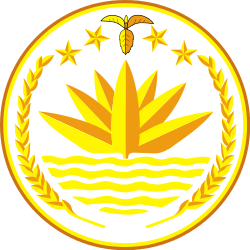Constitution of Bangladesh
 |
| This article is part of a series on the politics and government of Bangladesh |
|
Constitution |
|
Executive |
|
|
Political parties |
|
Foreign policy |
The Constitution of Bangladesh (Bengali: বাংলাদেশের সংবিধান Bangladesher Shongbidhan) is the supreme law of the People's Republic of Bangladesh. It was adopted on November 4, 1972. The constitution establishes a unitary state and a Westminster form of unicameral parliamentary democracy. It was originally handwritten in Bangla. A handwritten copy of the Constitution with signature from the constituent assembly members, is kept at the Attorney General's office in Dhaka. At present Bangladesh's Constitution and some other laws are available in English as well In Bangla. Following an Act of Parliament requiring all laws to be enacted in Bangla in 1987, laws made in Parliament are drafted in Bangla. [1]
The document's original drafters, notably Kamal Hossain, have called for major reforms to bring it in line with the 21st-century.[2]
Preamble

The preamble states the fundamental principles of the Bangladeshi republic, although it is not enforceable in a court of law.
Full text
We, the people of Bangladesh, having proclaimed our independence on the 26th day of March, 1971 and through a historic struggle for national liberation, established the independent, sovereign People's Republic of Bangladesh;Pledging that the high ideals of nationalism, socialism, democracy and secularism, which inspired our heroic people to dedicate themselves to, and our brave martyrs to sacrifice their lives in, the national liberation struggle, shall be the fundamental principles of the Constitution;
Further pledging that it shall be a fundamental aim of the State to realise through the democratic process a socialist society, free from exploitation a society in which the rule of law, fundamental human rights and freedom, equality and justice, political, economic and social, will be secured for all citizens;
Affirming that it is our sacred duty to safeguard, protect and defend this Constitution and to maintain its supremacy as the embodiment of the will of the people of Bangladesh so that we may prosper in freedom and may make our full contribution towards international peace and co operation in keeping with the progressive aspirations of mankind;
In our Constituent Assembly, this eighteenth day of Kartick, 1379 B.S., corresponding to the fourth day of November, 1972 A.D., do hereby adopt, enact and give to ourselves this Constitution.
Organs of the state
As per the constitution of the republic it comprises three basic organs:
- Legislative Branch
- Executive Branch
- Judicial Branch
Parts
The constitution of Bangladesh is divided into 11 parts, which are further subdivided into 153 articles.[3] In addition, there are 7 schedules.
Part I: The Republic
This section defines the nature of the country, its state religion and other national issues. According to it, Peoples Republic of Bangladesh is a unitary republic consisting of the territories of the former East Pakistan and also included territories (some enclaves exchanged with India). Even though the 1972 constitution clearly mentions secularism as one of its four pillars, military autocrat General H.M Ershad declared Islam as a state religion in the late 1980s. The Supreme Court, in 2010, upheld the secular nature of the constitution, declaring Ershad's promulgation unconstitutional. <http://zeenews.india.com/news/south-asia/bangladeshs-court-restores-secularism-in-constitution_644258.html> The state language is Bengali and the national anthem is the first ten lines of the song Amar Sonar Bangla. The national flag is a red circle on a green background. The national emblem is the national flower shapla (nympoea-nouchali) resting on water, having on each side and ear of paddy and being surmounted by three connected leaves of jute with two stars on each side of the leaves. This section also mandates that the portrait of prime minister must be displayed in all government, semi-government and autonomous offices. The capital of the country is Dhaka. The citizens are to be known as Bangladeshis.
Finally, Part I asserts that all powers belong to the people and the constitution, being the supreme law of the country, will supersede any other laws and regulations.
Part II: Fundamental principles of state policy
This part describes the fundamental principles. The original 1972 constitution had 4 basic principles: Secularity, Nationalism, Democracy and Socialism (meaning economic and social justice for all). However, later amendments replaced Secularity with "Absolute trust and faith in the Almighty Allah shall be the basis of all actions."[4]
Part II's article 9, 10, and 11 declares the rights of the people. Article 9 provides guidelines for quotas for the underrepresented communities, women, and peasants. Article 10 states the equal rights of women. Article 11 states that Bangladesh would be a democracy, with guaranteed human rights. Articles 13, 14, 15, and 16 deal with principal of ownership, emancipation of workers and peasants, provision of basic necessities, and rural development. Article 17 states that the basic education will be free and compulsory for all children.[5] The remaining articles (18-25) provide various guarantees for public health and morality, equality of opportunity, work as a right and duty, duties of citizens and of public servants, separation of Judiciary from the executive, national culture, national monuments, and promotion of international peace, security and solidarity, respectively.
Amendments
As of 2015 the Constitution of the People's Republic of Bangladesh has been amended 16 times.
References
- ↑ "Bangladesh's Constitution in Bengali,Online on Bangladesh Government Website.".
- ↑ "On Realising Our Constitutional Dreams". Forum. The Daily Star. November 2010.
- ↑ "Bangladesh 1972 (reinst. 1986, rev. 2011)". Constitute. Retrieved 17 March 2015.
- ↑ "Constitution of Bangladesh: Part II: Fundamental Principles of State Policy". Chief Adviser's Office. Prime Minister's Office. Government of the People's Republic of Bangladesh. Archived from the original on 6 January 2014.
- ↑ "THE CONSTITUTION OF THE PEOPLE'S REPUBLIC OF BANGLADESH: Article 17 (Free and compulsory education)".
External links
- "The Constitution of the People's Republic of Bangladesh". Laws of Bangladesh. Legislative and Parliamentary Affairs Division, Ministry of Law, Justice and Parliamentary Affairs. 2011. Retrieved July 23, 2014.
- Glimpses on pre-constitutional documents of Bangladesh